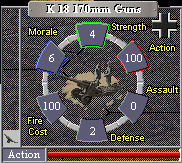
Game Statistics

|
| Victory Points |
Armour | Start | Start | End | End | ||
| Front | Side | Rear | Month | Year | Month | Year | |
| 7 | 0 | 0 | 0 | 1 | 42 | 5 | 45 |
| GebG K 18 170mm Gun | ||||||||||||||||||||||||||||
| RANGE | 1 | 2 | 3 | 4 | 5 | 6 | 7 | 8 | 9 | 10 | 11 | 12 | 13 | 14 | 15 | 16 | 17 | 18 | 19 | 20 | 30 | 40 | 50 | 60 | 70 | 80 | 90 | 100 |
| HARD | 22 | 19 | 16 | 13 | 9 | 5 | 2 | 2 | 2 | 2 | 2 | 2 | 2 | 2 | 2 | 2 | 2 | 2 | 2 | 2 | 2 | 2 | 2 | 2 | 2 | 2 | 2 | 2 |
| SOFT | 30 | 30 | 30 | 30 | 30 | 30 | 30 | 29 | 29 | 29 | 29 | 29 | 29 | 29 | 28 | 28 | 28 | 28 | 28 | 28 | 26 | 25 | 23 | 22 | 20 | 18 | 17 | 15 |
History
|
|
|
Specification |
|
This together with its partner piece the 210mm Mörse 18 was the mainstay of the German heavy artillery.The same carriage designed by Krupp was used for both weapons , for short distance movement it remained in one piece but for longer moves it could be split into two loads.For such moves the barrel was carried on a separate transport wagon.The 173mm Kanone 18 in Mörserlafette was introduced in 1941 to replace the 150mm weapons that by then had shown that their performance was insufficient for contemporary warfare.The gun itself was quiet orthodox but the carriage had a number of interesting features.A box-trail structure it was one of the first centainly the first in a quantity production to use the dual recoil system , in this design the barrel recoiled in its cradle in the usual way but in addition the top carriage (which carried the gun and the cradle) was permitted to recoil across the basic carriage body.Both systems were of the usual hydropneumatic type and the normal recoil lengths were 860mm for the gun in its cradle and 1250mm for the top carriage.The effect of this duel system was to damp out the recoil stresses so effectively that on firing the gun platform was very steady.The basic carriage carried an integral platform that could be lowered to the ground on going into action.The weight of the entire equipment was then transferred to the platform by jacking down three castor wheels that rode around its circumference , thus lifting the gun wheels from the ground.The trail end was supported on a spade float.To obtain large amounts of traverse the rear castor-wheel jack was operated to lift the trail and float clear from the ground , after which the whole weapon could easily be swung around the platform by two men. |